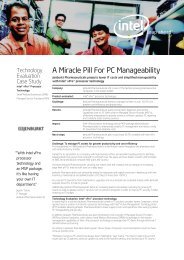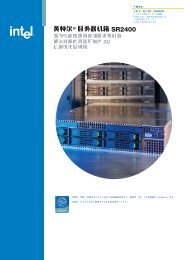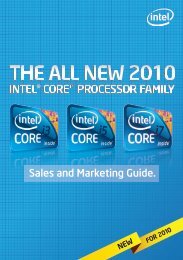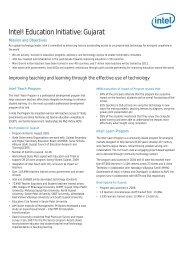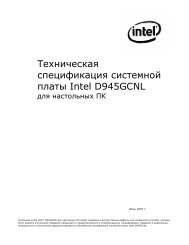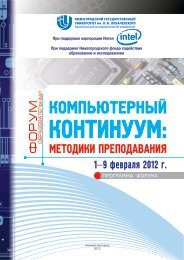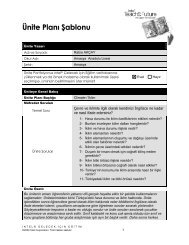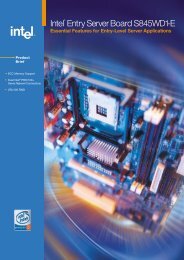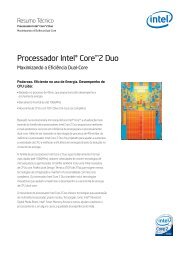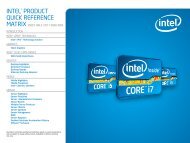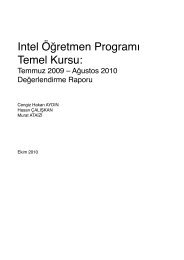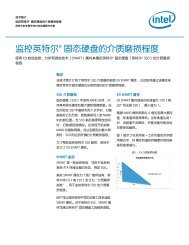Technical Product Specification for Canoe Pass - Preminary - Intel
Technical Product Specification for Canoe Pass - Preminary - Intel
Technical Product Specification for Canoe Pass - Preminary - Intel
Create successful ePaper yourself
Turn your PDF publications into a flip-book with our unique Google optimized e-Paper software.
<strong>Intel</strong> ® Server Board S2600CP and Server System P4000CP TPS<br />
<strong>Intel</strong> ® Server Board S2600CP and <strong>Intel</strong> ® Server System P4000CP Plat<strong>for</strong>m Management<br />
configuration is used. Based on the input provided, the FRUSDR writes sensor data specific to<br />
the configuration to NVRAM <strong>for</strong> the BMC controller to read each time the system is powered on.<br />
5.4 <strong>Intel</strong> ® <strong>Intel</strong>ligent Power Node Manager<br />
5.4.1 Overview<br />
Power management deals with requirements to manage processor power consumption and<br />
manage power at the plat<strong>for</strong>m level to meet critical business needs. Node Manager (NM) is a<br />
plat<strong>for</strong>m resident technology that en<strong>for</strong>ces power capping and thermal-triggered power capping<br />
policies <strong>for</strong> the plat<strong>for</strong>m. These policies are applied by exploiting subsystem knobs (such as<br />
processor P and T states) that can be used to control power consumption. NM enables data<br />
center power management by exposing an external interface to management software through<br />
which plat<strong>for</strong>m policies can be specified. It also implements specific data center power<br />
management usage models such as power limiting, and thermal monitoring.<br />
Note: Support <strong>for</strong> NM is product-specific. This section details how NM would be supported on<br />
products that provide this capability.<br />
The NM feature is implemented by a complementary architecture utilizing the ME, IBMC, BIOS,<br />
and an ACPI-compliant OS. The ME provides the NM policy engine and power control/limiting<br />
functions (referred to as Node Manager or NM) while the IBMC provides the external LAN link<br />
by which external management software can interact with the feature. The BIOS provides<br />
system power in<strong>for</strong>mation utilized by the NM algorithms and also exports ASL code used by<br />
OSPM <strong>for</strong> negotiating processor P and T state changes <strong>for</strong> power limiting. PMBus-compliant<br />
power supplies provide the capability to monitoring input power consumption, which is<br />
necessary to support NM.<br />
The NM architecture applicable to this generation of servers is defined by the NPTM<br />
Architecture <strong>Specification</strong> v2.0. NPTM is an evolving technology that is expected to continue to<br />
add new capabilities that will be defined in subsequent versions of the specification. The ME NM<br />
implements the NPTM policy engine and control/monitoring algorithms defined in the NPTM<br />
specification.<br />
5.4.2 Hardware Requirements<br />
NM is supported only on plat<strong>for</strong>ms that have the NM FW functionality loaded and enabled on<br />
the Management Engine (ME) in the SSB and that have an IBMC present to support the<br />
external LAN interface to the ME. NM power limiting features requires a means <strong>for</strong> the ME to<br />
monitor input power consumption <strong>for</strong> the plat<strong>for</strong>m. This capability is generally provided by<br />
means of PMBus-compliant power supplies although an alternative model using a simpler<br />
SMBus power monitoring device is possible (there is potential loss in accuracy and<br />
responsiveness using non-PMBus devices). The NM SmaRT/CLST feature does specifically<br />
require PMBus-compliant power supplies as well as additional hardware on the baseboard.<br />
5.4.3 Features<br />
NM provides feature support <strong>for</strong> policy management, monitoring and querying, alerts and<br />
notifications, and an external interface protocol. The policy management features implement<br />
specific IT goals that can be specified as policy directives <strong>for</strong> NM. Monitoring and querying<br />
features enable tracking of power consumption. Alerts and notifications provide the foundation<br />
<strong>for</strong> automation of power management in the data center management stack. The external<br />
interface specifies the protocols that must be supported in this version of NM.<br />
Revision 0.8 <strong>Intel</strong> Confidential<br />
<strong>Intel</strong> order number G26942-003<br />
59



